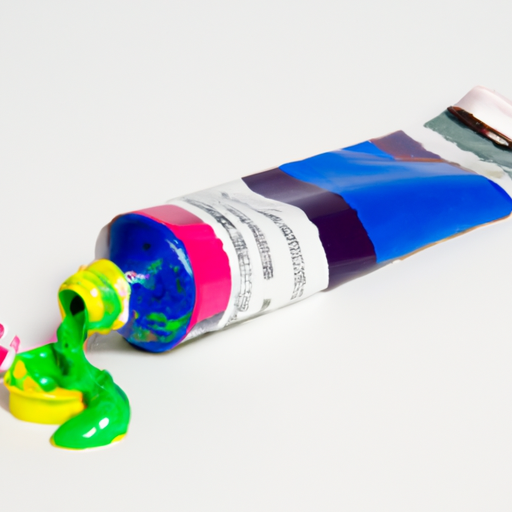In this article, you will learn a simple and easy technique on how to open an acrylic paint tube effortlessly. We’ve all been there, struggling with those stubborn paint tubes that seem determined to stay sealed. But fear not! With just a few steps, you’ll be able to unlock the vibrant colors of your acrylic paints without any frustration. So grab your paint tube and get ready to discover the secret to hassle-free paint tube opening!

1. Understanding Acrylic Paint Tubes
1.1 What are Acrylic Paint Tubes?
Acrylic paint tubes are containers that hold acrylic paint, a versatile and vibrant medium used by artists of all skill levels. These tubes are commonly made of aluminum or plastic and are designed to keep the paint fresh and prevent it from drying out. They come in various sizes and colors, making them convenient and easy to use for artworks ranging from small sketches to large-scale paintings.
1.2 Importance of Properly Opening Tubes
Properly opening acrylic paint tubes is crucial for several reasons. Firstly, it ensures that the paint is accessible and ready to use whenever inspiration strikes. Secondly, opening tubes correctly prevents damage to the tube itself, allowing for repeated and effortless use. Lastly, improper opening techniques can result in dried or hardened paint that compromises the overall quality and usability of the acrylic paint. By understanding the correct methods for opening acrylic paint tubes, you can enhance your painting experience and maintain the longevity of your paints.
2. Essential Tools and Materials
2.1 Basic Tools Needed
To open acrylic paint tubes effectively, you will need a few basic tools. The primary tool is a tube key or pliers, which helps you grip and twist the cap with ease. Additionally, having a clean cloth or paper towel nearby is essential for wiping off any excess paint or residue that may accumulate on the tube or cap. Lastly, it is advisable to have a flat surface or table to work on, ensuring stability and preventing any accidental spills during the opening process.
2.2 Safety Precautions to Consider
While opening acrylic paint tubes may seem like a simple task, it is important to prioritize safety. Remember to wear protective gloves to avoid any potential skin irritation or allergic reactions from prolonged contact with the paint. Additionally, ensure that the area you are working in is well-ventilated to prevent inhalation of any fumes that may be emitted from the paint. By taking these safety precautions, you can enjoy your painting process without any health concerns.
3. Preparing the Tube
3.1 Checking the Tube for Damage
Before opening your acrylic paint tube, it is essential to examine it for any signs of damage. Look for dents, punctures, or leaks that may compromise the integrity of the paint inside. If you notice any damage, use caution when opening the tube to prevent any further spillage or contamination. If the damage is severe, it is advisable to transfer the paint into a separate container or consider replacing the tube.
3.2 Cleaning the Tube Surface
To ensure a smooth opening process and prevent any unwanted debris from entering the paint, it is recommended to clean the tube surface before opening. Use a clean cloth or paper towel dampened with water to gently wipe away any dirt, dust, or dried paint that may have accumulated on the tube. This step will help maintain the cleanliness of your paint and prevent any contaminants from affecting your artwork.
4. Techniques for Opening Acrylic Paint Tubes
4.1 The Squeeze and Twist Method
The squeeze and twist method is the most common and straightforward way to open acrylic paint tubes. Start by firmly gripping the tube with one hand, ensuring a secure hold. With your other hand, place your thumb on the top of the cap and your fingers on the bottom. Apply gentle pressure as you squeeze the tube slightly, creating a small gap between the cap and the tube. Once the gap is created, twist the cap counterclockwise to unscrew it fully. This technique allows for a controlled and gradual opening of the tube.
4.2 Using a Tube Key or Pliers
If you find it challenging to open an acrylic paint tube using the squeeze and twist method, a tube key or pliers can provide additional leverage. Place the tube key or pliers around the cap, ensuring a secure grip. Apply gentle pressure and turn the key or pliers counterclockwise to loosen and remove the cap. Be careful not to apply excessive force that may damage the tube or cause paint spillage. The use of these tools can greatly assist in opening stubborn or tightly sealed tubes.

5. Dealing with Stubborn Tubes
5.1 Applying Heat to Loosen the Cap
If you encounter a stubborn acrylic paint tube that refuses to open, applying heat can be a useful technique. Use a hairdryer on a low or medium setting and direct the warm air towards the cap for a few minutes. The gentle heat helps expand the metal or plastic, making it easier to twist off. Remember to work slowly and cautiously, as excessive heat can damage the paint or tube. This method is especially effective for tubes that have been exposed to cold temperatures, causing the paint to thicken and the cap to tighten.
5.2 Soaking the Tube in Warm Water
Another method to loosen stubborn acrylic paint tubes is by soaking them in warm water. Fill a shallow container with warm water and place the tube, ensuring the cap is fully submerged. Allow the tube to soak for approximately 10-15 minutes, as the heat and moisture will help loosen the cap. After soaking, carefully pat the tube dry to remove any excess water. Now, try using the squeeze and twist method or a tube key/pliers to open the tube. The warm water softens the paint and cap, allowing for easier access.
6. Proper Storage and Maintenance
6.1 Sealing the Tube Properly
To maintain the quality and longevity of your acrylic paint, it is crucial to seal the tube properly after each use. Ensure that the cap is tightly closed by using the squeeze and twist method or a tube key/pliers. By sealing the tube tightly, you prevent air from entering and drying out the paint, preserving its consistency for future use. Properly sealing your acrylic paint tubes also reduces the likelihood of spills or leaks, keeping your workspace neat and organized.
6.2 Avoiding Drying or Cracking
To prevent your acrylic paint from drying or cracking, it is vital to store your tubes in a cool and dry place, away from direct sunlight or extreme temperatures. Exposure to heat, cold, or excessive humidity can compromise the quality of the paint, causing it to become thick, clumpy, or unusable. Additionally, make sure the caps are securely closed to maintain a tight seal and minimize air exposure. By implementing these storage practices, you can extend the shelf life of your acrylic paint tubes.

7. Troubleshooting Common Issues
7.1 When the Cap Gets Stuck
Occasionally, the caps of acrylic paint tubes can become stuck, making it difficult to open them. If this happens, do not force the cap, as it may lead to damage or spillage. Instead, wrap a rubber band around the cap to increase your grip and provide better traction. The rubber band acts as a gripper, allowing you to twist the cap with more ease. This simple trick often provides the extra leverage needed to open stubbornly stuck caps.
7.2 Preventing Paint from Drying in the Cap
One common issue with acrylic paint tubes is the drying of paint in the cap, making it challenging to open the tube. To avoid this, after each use, wipe off any excess paint from the cap and tube opening using a clean cloth or paper towel. This prevents any residual paint from drying and creating a seal between the cap and the tube. By keeping the cap clean and free of dried paint, you ensure a smooth opening process every time.
8. Tips and Tricks for Opening Acrylic Paint Tubes
8.1 Squeezing from the Bottom Upwards
To maximize the amount of paint extracted from the tube, a helpful tip is to squeeze the tube from the bottom upwards. This technique forces the paint towards the cap, making it easier to dispense and reducing wastage. By gradually squeezing and moving upwards, you can control the flow of paint and avoid any excess seepage or mess. Remember to maintain a steady grip on the tube while applying pressure to ensure a controlled release of the paint.
8.2 Using Tube Openers or Grippers
If you frequently struggle with opening acrylic paint tubes or have limited hand strength, consider investing in tube openers or grippers. These handy tools provide a strong and comfortable grip, allowing you to effortlessly twist off the caps. Tube openers or grippers come in various designs and sizes, accommodating different tube sizes and materials. They are particularly beneficial for artists with arthritis or other conditions that affect hand dexterity, making the opening process much easier and more enjoyable.

9. Frequently Asked Questions
9.1 How long can acrylic paint last in a tube?
Acrylic paint can last for an extended period when stored properly in tubes. On average, acrylic paint can remain usable for several years, depending on factors such as the quality of the paint and the storage conditions. To ensure the longevity of the paint, store the tubes in a cool, dry, and dark place, away from direct sunlight or extreme temperatures. Remember to seal the tubes tightly after each use to minimize air exposure and prevent premature drying.
9.2 Can I use pliers to open the tube without a key?
Yes, pliers can be used to open acrylic paint tubes in the absence of a tube key. However, exercise caution and ensure the pliers have a strong grip, as excessive force may damage the tube or cause paint spillage. Wrap a cloth or use rubber bands around the plier jaws to prevent any marks or indentations on the tube. It is important to note that using pliers should be a last resort if the squeeze and twist method alone is ineffective.
10. Conclusion
10.1 Summary of Steps
Opening acrylic paint tubes correctly is a fundamental skill for any artist. By following the steps outlined in this article, you can open your tubes with ease and maintain the quality of your paints. Start by understanding the importance of proper opening techniques and gathering the necessary tools and materials. Prepare the tube by checking for damage and cleaning the surface. Utilize techniques such as the squeeze and twist method or using a tube key/pliers for opening the tubes. When dealing with stubborn tubes, experiment with applying heat or soaking them in warm water. Properly seal the tubes after each use, and store them in a cool, dry place to avoid drying or cracking. Troubleshoot common issues such as stuck caps or dried paint in the cap, and utilize tips like squeezing from the bottom upwards or using tube openers/grippers. Remember that acrylic paint can last for years if stored properly, and pliers can be used as an alternative to a tube key.
10.2 Final Thoughts
Opening acrylic paint tubes should be an effortless and enjoyable experience that sets the stage for your artistic journey. By mastering the proper techniques and following the tips and tricks shared in this article, you can ensure that your paints are always accessible, fresh, and ready to unleash your creativity. Take the time to understand the individual characteristics of your acrylic paint tubes, and prioritize their proper storage and maintenance. With these practices in place, you can confidently embark on your artistic endeavors, knowing that your acrylic paint tubes will always be there to support your artistic vision. Happy painting!




